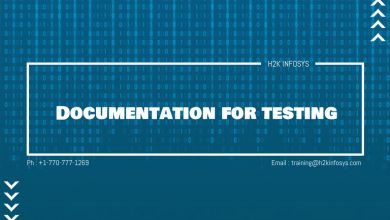
SAP Testing TYPES:
CLICK TO READ ‘SAP TESTING’
- Unit Testing: This testing is taking care by the developers as per the rules and regulations of the unit testing for any organisation. This testing is done in the development box. This is the testing done for interfaces, conversions, enhancement, reports, workflows developed primarily with ABAP code.
- Integration Testing: This is the type of testing of combined components of application to determine if they function together properly.
- Regression testing: It is the testing which is done to know that new changes implemented will not adversely affect the existing working code. SAP\R3 is a integrated system. A single stack update, OSS note, transport note, new development interfaces can have many cascading and severe effect.
- Performance Testing: It is a testing type of SAP application software, whether they will perform well under expected workload. Performance testing encompass load, volume and stress testing to determine the mistakes. The SAP testing includes checking business processes that may cause stress. The main goal of this testing is to enhance the robustness of SAP application and helps systems that can sustain the high load forecast with zero post production performance issues.
- Functional testing: It confirms that your implementation of SAP meets your business requirements. SAP is highly configurable system and could be easily integrated with other applications or third party tools.
- User Acceptance testing: it assures that SAP testing is useful for end users of the systems. The end users can independently execute the user acceptance test cases which include testing business processes, documentation, functions.
- Security testing: High security for SAP portal like SAP portal security, network security, operational security, product security and source code audit is tested.
- Portal testing: The process involves testing the SAP portals on different web browser and checking in business processes.
Questions
- What is SAP testing explain with an example?
- What are the different phases of SAP?
- What are the advantages of SAP?
Facebook Comments







1. What is SAP testing explain with an example?
SAP (Systems, Applications, and Products) testing is application testing. It involves testing focused on evaluating the features of SAP – primarily the ability for customers to interact with corporate databases for a comprehensive range of applications.
An example of SAP testing would be testing related to the example presented in the article: for SAP implementation that the company A will provide 10 leaves to an employee and company B will provide 20 annual leaves for an employee. The salary should be deducted if an employee processes for 12th or 13th leave. This information must be passed to SAP systems which is SAP implementation and configuration.
2. What are the different phases of SAP?
Test Preparation
Test execution Phase
Test evaluation phase
3. What are the advantages of SAP?
The advantages of SAP testing are the numerous types of SAP testing that can be implemented to improve test coverage, such as: unit testing, integration testing, regression testing, performance testing, functional testing, UAT, security testing, and portal testing.
What is SAP testing explain with an example?
SAP Testing is about testing the functionality of various SAP modules like financial, logistics, human resource management..etc,and to ensure that they perform as per the configuration.The SAP means Systems, Applications and Products in data processing. It provides the ability to customers, to interact with the corporate databases for a comprehensive range of applications. The SAP testing is application testing. Here the application is SAP ERP software. ERP is Enterprise Resource Planning. The customers can run the business process using ERP software.It involves complete end-to-end testing and validation of all SAP modules in SAP ERP environment.To perform SAP testing, you need to understand the features, functionalities, and how the workflow takes place in these SAP modules. Most of the common reasons of failure of ERP implementation project is incorrect test planning and the use of wrong test-cases.
->For Example, you have to create a Sales Order in Sales and Distribution (SD) module. Here, you first need to enter the transaction code(e.g., Transaction Code VA01). Next, check the stock of the item in Inventory module and check the credit limit available on Customer profile in Customer Relationship Module. It shows that all these modules are interdependent; if you customize any of these modules, it will affect the related ERP system.
-> Three different testing phases of SAP are:
1.Test Preparation
– Identification of business process.
– Development of manual test cases and automated cases.
– Creation of test plans & review.
– Set up of test system(Dev,Quality,Pre production system).
– Creation of test data.
2.Test execution Phase
– Test execution using test tools such as Solution Manager,HP Quality Center ,HP ALM.
– Test status reporting & defect handling.
3.Test evaluation phase
– Detailed assessment of all test plans
– Defect Analysis
– Documentation of the testing process
What are the advantages of SAP?
– It ensures the quality of SAP system and also focuses on revenue and cost of the organization.
– Reducing the SAP development costs and improve predictability.
– Ensures that the SAP implementation is meeting the new compliance requirements in a specific organization and all the modules are working as per the expected configuration.
– Ensure if the system will be able to meet the Service Level agreements, time taken by system to perform specific actions, performance of the system, etc.
– SAP allows customers to interact with different databases to run different applications with the help of user-friendly GUI.
There are different testing methods that can be used to test the functionality of a software, system, or an application.
The most common testing techniques are −
1. Unit testing
2. Integration testing
3. Regression testing
4. Performance testing
5. Functional testing
6. User acceptance testing
7. security testing
1.SAP is an application testing. It provides the ability to customers to interact with the corporate database for a comprehensive range of application. example the company A will provide 10 leaves to an employee and company B will provide 20 annual leaves for an employee. The salary should be deducted if an employee process for 12th or 13th leave.This information should be passed to SAP implementation and configuration.
2. Different phases of SAP are:
a. Test preparation
b. Test execution
c. test evaluation
3.Advantages of SAP testing are cost efficient, can accept new changes, user friendly.
The SAP means Systems, Applications and Products in data processing. It provides the ability to customers, to interact with the corporate databases for a comprehensive range of applications. The SAP testing is application testing. Here the application is SAP ERP software. ERP is Enterprise Resource Planning. The customers can run the business process using ERP software.
the life cycle you may be working there are three different testing phases -Test Preparation ,Test execution Phase , Test evaluation phase.
advantages-The main goal of this testing is to enhance the robustness of SAP application and helps systems that can sustain the high load forecast with zero post production performance issues.High security for SAP portal like SAP portal security, network security, operational security, product security and source code audit is tested.
(1) The SAP means Systems, Applications and Products in data processing. It provides the ability to customers, to interact with the corporate databases for a comprehensive range of applications. The SAP testing is application testing. Here the application is SAP ERP software. ERP is Enterprise Resource Planning. The customers can run the business process using ERP software.with the corporate databases for a comprehensive range of applications. The SAP testing is application testing. Here the application is SAP ERP software. ERP is Enterprise Resource Planning. The customers can run the business proces.
(2) 1. Test preparation
2. Test execution
3. Test evaluation
(3) 1. Validation of system
2. Improves quality and increases revenue of organization
3. reduces cost and improves predicability
4. Checks system integration
1) The SAP means Systems, Applications and Products in data processing. It provides the ability to customers, to interact with the corporate databases for a comprehensive range of applications. The SAP testing is application testing. Here the application is SAP ERP software. ERP is Enterprise Resource Planning. The customers can run the business process using ERP software.with the corporate databases for a comprehensive range of applications
The life cycle you may be working there are three different testing phases -Test Preparation ,Test execution Phase , Test evaluation phase.
advantages-The main goal of this testing is to enhance the robustness of SAP application and helps systems that can sustain the high load forecast with zero post production performance issues.High security for SAP portal like SAP portal security, network security, operational security, product security and source code audit is tested.
The SAP means Systems, Applications and Products in data processing. It provides the ability to customers, to interact with the corporate databases for a comprehensive range of applications. The SAP testing is application testing. Here the application is SAP ERP software. ERP is Enterprise Resource Planning. The customers can run the business process using ERP software.
Test Preparation
Test execution Phase
Test evaluation phase
Improves quality and increases revenue of organization
reduces cost and improves predictability
Checks system integration
SAP TESTING
The SAP means Systems, Applications and Products in data processing. It provides the ability to customers, to interact with the corporate databases for a comprehensive range of applications. The SAP testing is application testing. Here the application is SAP ERP software. ERP is Enterprise Resource Planning. The customers can run the business process using ERP software.
Different phases of SAP are :-
Test preparation
Test execution
Test evaluation
Advantages: System Validation, Quality & Revenue, Cost & Predictability, Compliance Requirement, New Implementattion & Configuration Changes, Integration, Performance.
SAP testing is application testing. The application here is SAP ERP software. An example would be to conduct performance testing. Performance testing is conducted to check if the SAP application software will perform well under expected workload. (load, volume and stress)
3 different testing phases:
• Test plan
• Test execution
• Test evaluation
The advantages of SAP are that the basic functionality remains the same with only slight variations or customizations made by each company.
What is SAP testing explain with an example?
ans : The SAP testing is application testing. It provides the ability to customers, to interact with the corporate databases for a comprehensive range of applications. Here the application is SAP ERP software.
Consider an example, for SAP implementation that the company A will provide 10 leaves to an employee and company B will provide 20 annual leaves for an employee. The salary should be deducted if an employee processes for 12th or 13th leave. This information must be passed to SAP systems which is SAP implementation and configuration.
2. What are the different phases of SAP?
There are three different testing phases.
Test Preparation
Test execution Phase
Test evaluation phase
3. What are the advantages of SAP?
In SAP testing, the functional knowledge you acquire is portable and can be used in other projects.
If you are switching job in your old company or if you were testing billing software for telecom service provider, what is the possibility that the same project is available in your new company. Now in case, that your are switching from SAP testing project to another SAP testing project in your new company. You instantly recognise the GUI, transaction codes, vanilla business workflows
3. advantage of sap
The advantages of SAP testing are the numerous types of SAP testing that can be implemented to improve test coverage, such as: unit testing, integration testing, regression testing, performance testing, functional testing, UAT, security testing, and portal testing.
1- Unit testing : typically automated tests written and run by software developers to ensure that a section of an application (known as the “unit”) meets its design and behaves as intended.
In procedural programming, a unit could be an entire module, but it is more commonly an individual function or procedure. In object-oriented programming, a unit is often an entire interface, such as a class, but could be an individual method.
By writing tests first for the smallest testable units, then the compound behaviors between those, one can build up comprehensive tests for complex applications.
2- Integration testing is Integrate/combine the unit tested module one by one and test the behavior as a combined unit.
The main function or goal of this testing is to test the interfaces between the units/modules.
We normally do Integration testing after “Unit testing”. Once all the individual units are created and tested, we start combining those “Unit Tested” modules and start doing the integrated testing.
The main function or goal of this testing is to test the interfaces between the units/modules.
The individual modules are first tested in isolation. Once the modules are unit tested, they are integrated one by one, till all the modules are integrated, to check the combinational behavior, and validate whether the requirements are implemented correctly or not.
3-Regression testing is a Software Testing type in which test cases are re-executed in order to check whether the previous functionality of the application is working fine and the new changes have not introduced any new bugs.
This test can be performed on a new build when there is a significant change in the original functionality that too even in a single bug fix.
Regression means retesting the unchanged parts of the application.
4-Performance testing : non-functional testing technique performed to determine the system parameters in terms of responsiveness and stability under various workload. Performance testing measures the quality attributes of the system, such as scalability, reliability and resource usage.the performance test techniques are load testing, stress testing, soak testing, spike testing.
5- Functional testing testing is provides the guidance, validation, and inspiration that QA teams need in order to deliver great software products.
6- User acceptance testing – (UAT) is a type of testing performed by the end user or the client to verify/accept the software system before moving the software application to the production environment. UAT is done in the final phase of testing after functional, integration and system testing is done.
7- SECURITY TESTING is a type of Software Testing that uncovers vulnerabilities, threats, risks in a software application and prevents malicious attacks from intruders. The purpose of Security Tests is to identify all possible loopholes and weaknesses of the software system which might result in a loss of information, revenue, repute at the hands of the employees or outsiders of the Organization.This is usually 8- PORTAL TESTING involves the basis, database, infrastructure, development and test teams. Portal Testing: These techniques involve testing the SAP Portals on different browser and checking business processes.
SAP Unit Testing.
SAP System Testing.
SAP Scenario / String Testing.
SAP Integration Testing.
SAP Interface Testing.
SAP End-to-End Testing.
SAP End User Testing & User Acceptance Testing.
SAP Stress / Load / Performance Testing.
SAP testing is essentially application testing and has 3 phases
1. Test preparation
2. Test execution
3. Test evaluation
SAP implementation leads to
1. Validation of system
2. Improves quality and increases revenue of organization
3. reduces cost and improves predicability
4. Checks system integration
The SAP means Systems, Applications and Products in data processing. It provides the ability to customers, to interact with the corporate databases for a comprehensive range of applications. The SAP testing is application testing. Here the application is SAP ERP software. ERP is Enterprise Resource Planning. The customers can run the business process using ERP software.
2. Phases of SAP:
Test Preparation
Test execution Phase
Test evaluation phase
The advantages of SAP are that the basic functionality remains the same with only slight variations or customizations made by each company.
1.The SAP means Systems, Applications and Products in data processing. It provides the ability to customers, to interact with the corporate databases for a comprehensive range of applications. The SAP testing is application testing. Here the application is SAP ERP software. ERP is Enterprise Resource Planning. The customers can run the business process using ERP software.
2.Test preparation
Test execution
Test evaluation
3.Provides control over various business processes.
Increases prductivity, better inventory management, promotes quality, reudced material cost, effective human resources management and boosts profits.
Acquired functional knowledge is portable and can be used in other projects as well
The SAP testing is application testing. Here the application is SAP ERP software. ERP is Enterprise Resource Planning.
The customers can run the business process using ERP software.
The SAP means Systems, Applications and Products in data processing.
It provides the ability to customers, to interact with the corporate databases for a comprehensive range of applications.
There are three different testing phases. 1.Test Preparation 2.Test execution Phase 3.Test evaluation phase
The advantages are user friendly, cost effecient, can accept new changes.
1. SAP means Systems, Applications and Products in data processing. It provides the ability to customers, to interact with the corporate databases for a comprehensive range of applications. SAP testing is application testing. Consider an example, for SAP implementation that the company A will provide 10 leaves to an employee and company B will provide 20 annual leaves for an employee. The salary should be deducted if an employee processes for 12th or 13th leave. This information must be passed to SAP systems which is SAP implementation and configuration.
2. There are three different testing phases: Test Preparation, Test execution phase, and Test evaluation phase.
3. The advantages of SAP include that there are many types of implementation, It provides the ability to customers, to interact with the corporate databases for a comprehensive range of applications, and Increases productivity, better inventory management, promotes quality, reduced material cost, effective human resources management and boosts profits.
What is SAP testing explain with an example?
The SAP testing is application testing.
Company A will provide 10 leaves to an employee and company B will provide 20 annual leaves for an employee. The salary should be deducted if an employee processes for 12th or 13th leave. This information must be passed to SAP systems which is SAP implementation and configuration.
What are the different phases of SAP?
Test Preparation
Test execution Phase
Test evaluation phase
What are the advantages of SAP?
Customized solutions, increased productivity and efficiency, Cost efficiency.
What is SAP testing explain with an example?
The SAP means Systems, Applications and Products in data processing. It provides the ability to customers, to interact with the corporate databases for a comprehensive range of applications. The SAP testing is application testing. Here the application is SAP ERP software. ERP is Enterprise Resource Planning. The customers can run the business process using ERP software.
For example,
If you are switching job in your old company or if you were testing billing software for telecom service provider, what is the possibility that the same project is available in your new company.
The company A will provide 10 leaves to an employee and company B will provide 20 annual leaves for an employee. The salary should be deducted if an employee processes for 12th or 13th leave.
What are the different phases of SAP?
There are three different testing phases.
1. Test Preparation
2. Test execution Phase
3. Test evaluation phase
What are the advantages of SAP?
1. Expensive
2. Not Very flexible
3. Very complex
4. Demands very highly trained staff
5. Lengthy implementation time
What is SAP testing explain with an example?
SAP Testing is like any other Software Application Testing ,but the application here is an ERP(Enterprise Resource Planning) application. It is about testing the functionalities of various SAP Modules and ensure they work as per the requirement.
Example : SAP Testing for a manufacturing company. Here you will do the testing for key operations in fields of HR, Plant Maintenance, Supply Chain ,etc and ensure that the modules all perform as per the configuration.
What are the different phases of SAP?
The different phases of SAP are :
* Test Preparation Phase
* Test Execution Phase.
* Test Evaluation Phase.
What are the advantages of SAP?
Since SAP requires a deep functional knowledge, it becomes easily portable. In other words if you move from one SAP testing Project to another you will still be able to easily recognize the GUI ,the transaction codes and the workflow. SAP Testing helps in the following :
* Ensuring quality and increases revenue
* Cost effective
* Increased Scope.
1. What is SAP testing explain with an example?
SAP stands for System, application and Product in data processing. The SAP testing is an application testing. Here the application is SAP ERP software For example – you are switching from one SAP testing project to another SAP testing project in your new company. You instantly recognize the GUI, transaction codes, vanilla business workflows
2. What are the different phases of SAP?
there are three different testing phases.
Test Preparation
Test execution Phase
Test evaluation phase
3.What are the advantages of SAP?
Advantages :
For small and large business, not expensive to maintain and cost efficient.
1. SAP testing is application testing, it provides the ability to customers, to interact with the corporate databases for a comprehensive range of applications. an example is switching jobs and finding the same job/project at a new company
2. the different phases are
Test Preparation
Test execution Phase
Test evaluation phase
3. the advantage of SAP is the functional knowledge gained during SAP testing is portable and can be used in other projects.
Thank you for sharing your blog, seems to be useful information can’t wait to dig deep!
1. What is SAP testing explain with an example?
SAP stands for System, application and Product in data processing. The SAP testing is an application testing. Here the application is SAP ERP software For example – you are switching from one SAP testing project to another SAP testing project in your new company. You instantly recognize the GUI, transaction codes, vanilla business workflows
2. What are the different phases of SAP?
there are three different testing phases.
Test Preparation
Test execution Phase
Test evaluation phase
3.What are the advantages of SAP?
Advantages :
For small and large business, not expensive to maintain and cost efficient.
1. The SAP means Systems, Applications and Products in data processing which provides the ability to customers to interact with the corporate database for a comprehensive range of applications. The SAP testing is the application testing. In SAP testing the functional knowledge you acquire is portable and can be used in other projects. For e.g. if you are switching job in your old company or if you were testing billing software for telecom service provider, what is the possibility that the same project is available in your new company. Now in case that you are switching from SAP testing project to another SAP testing project in your new company. You instantly recognize the GUI, transaction codes, vanilla business workflows. You have to learn the customization made by the customer but still should have the deep knowledge about the software.
2. There are three different phases of SAP as
1. Test Preparation Phase.
2. Test Execution Phase.
3. Test evaluation Phase
3. Some of the advantages of SAP are as follows.
SAP ERP provides solutions for industry specific need with a comprehensive set of integrated and cross functional business processes.
1. SAP is based on open technology that supports and can run on multiple operting systems and databases.
2. It supports customization to enhance / change the application as per organization own business process and requirements.
3. It helps to run the enterprise in accordance with strategy and plans, providing the correct information in real time to take
proper decisions.
4. It helps to improve operational efficiency, productivity, reduce costs and risks.
5. SAP improves financial and accounting management, increases visibility on your business achievement and improve
financial control.
6. It increases profitability with high ROI.